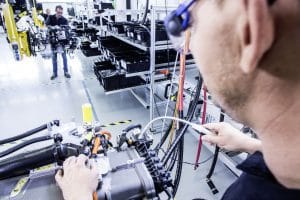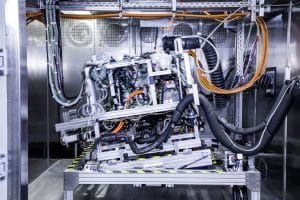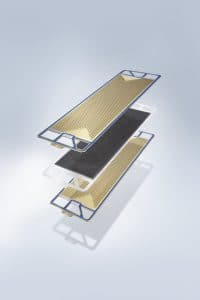
A worker conducts a test on the fuel cell unit moving down the assembly line at Daimler’s plant in Kirchheim-Nabern.
Two of the world’s biggest makers of big commercial trucks, Daimler AG and Volvo Group, are teaming up to work on the development of trucks powered by fuel cells.
“Transport and logistics keep the world moving, and the need for transport will continue to grow. Truly (carbon dioxide)-neutral transport can be accomplished through electric drivetrains with energy coming either from batteries or by converting hydrogen on board into electricity,” said Martin Daum, chairman of the Board of Management Daimler Truck AG, which is taking control of all of Daimler AG’s fuel-cell projects as part of the deal.
Daum noted, for trucks to cope with heavy loads and long distances, fuel cells are “one important answer and a technology where Daimler has built up significant expertise through its Mercedes-Benz fuel cell unit over the last two decades. This joint initiative with the Volvo Group is a milestone in bringing fuel cell-powered trucks and buses onto our roads.”
(Daimler, Volvo pondering potential engine partnership.)
Martin Lundstedt, Volvo Group president and CEO, said electrification large trucks is critical to the success of the so-called Green Deal, a carbon neutral Europe and ultimately a carbon neutral world. Using hydrogen as a carrier of green electricity to power electric trucks in long-haul operations is one important part of the puzzle, and a complement to battery electric vehicles and renewable fuels, Lundstedt said.

Development tests on the drive unit of the Mercedes-Benz GLC F-CELL, including testing in freezing conditions with the drive unit tilted at different angles.
The two sides expect to accelerate fuel cell development and reduce costs by merging their efforts in the arena. However, “for this vision to become reality, other companies and institutions also need to support and contribute to this development, not least in order to establish the fuel infrastructure needed,” Lundstedt noted.
A hydrogen fuel cell converts the chemical energy of the fuel, in this case hydrogen, and oxygen (in the air) into electricity. The electricity powers the electrical motors that propel an electrical vehicle.
Currently, there are two main ways to produce the hydrogen needed.
Green hydrogen can be produced locally at the gas station, using electricity to convert water into hydrogen. Blue hydrogen is expected to be produced from natural gas, utilizing carbon capture technology to create a carbon neutral fuel.
(Geely gets Smart with Daimler.)
Distribution, however, is a major hurdle for any hydrogen fuel but commercial vehicles are con
sidered because they usually travel on fixed routes and can be re-fueled at fleet-oriented service centers.
The Volvo Group and Daimler Truck AG will be 50/50 partners in the joint venture, which will operate as an independent and autonomous entity, with Daimler Truck AG and the Volvo Group continuing to be competitors in all other areas of business.
The common goal is for both companies to offer heavy-duty vehicles with fuel cells for demanding long-haul applications in series production in the second half of the decade. In addition, other automotive and non-automotive use cases are also part of the new joint venture’s scope.
To enable the joint venture, Daimler Trucks is bringing together all group-wide fuel cell activities in a new Daimler Truck fuel cell unit.
(Daimler expands customer experience electric truck fleet.)
The joint venture will include the operations in Nabern/Germany (currently headquarters of the Mercedes-Benz Fuel Cell GmbH) with production facilities in Germany and Canada. The signed preliminary agreement is non-binding. A final agreement is expected by Q3 and closing before year-end 2020, pending approval by governmental agencies in Europe.

